Stille Nacht
, Dresden

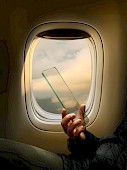
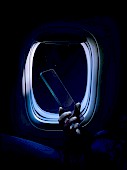

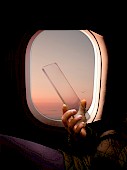

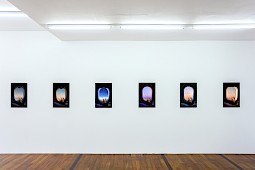

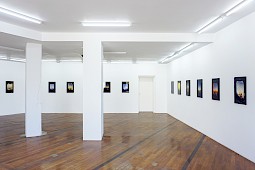
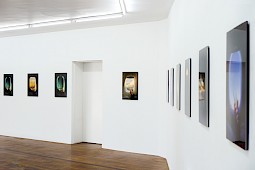
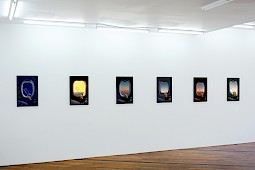

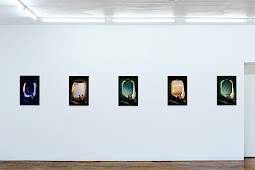
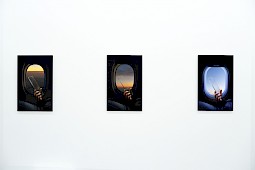

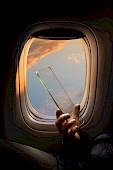


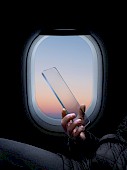
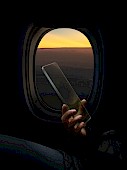

We are pleased to present Tilman Hornig in his eighth solo exhibition at Galerie Gebr. Lehmann. Tilman Hornig shows new photographs from his series of "GlassPhones", on which he has been working continuously since 2014.
Text for the exhibition by Katarina Lozo:
During his studies at the HfBK Dresden mainly active as a painter, Tilman Hornig's (*1980) work today is characterized by a strong medial diversity, the constant interweaving with contemporary phenomena and thus also digital image worlds. The further development and deepening of motifs in ongoing groups of works is based on a conceptual approach, which, however, manages without pathos or claim to truth due to the free, almost playful implementation in different scenarios and formats. Exemplary for this artistic practice is the group of works "GlassPhone", begun in 2014. A simple, glass object is readable here solely through its form as a smartphone and Hornig stages it accordingly as an applied sculpture.
Digital photographs and videos show omnipresent situations: Women and men hold the fictitious device in their hands, stretch it out to take a photo, look at the supposed screen, wipe their fingers across the transparent surface, scroll through an invisible feed or type a message.
These are strikingly unspecific and yet even more familiar motifs that evoke the clear aesthetics of advertising and stock photography. Also because people and places step back behind the object to give space to a universal truth. The device abstracted here into a symbol is real for almost everyone everywhere - in the private bedroom, in a café, in a museum, on a plane, in public urban space, in nature - and still remains only a tool for the virtual world.
By throwing back the symbol of digital space, limitless communication, infinite information to its purely material form, Hornig makes the paradoxical cultural elevation visible. For the device as such is free of any content, it is a neutral surface and at no time permanent. Only at the moment of use does it transfer the surrounding reality into a virtual illusion of the same, thus becoming a mirror of countless, varying realities. The transparency of the "GlassPhone" refers to the actual function of the smartphone as a transmitter of information and translator between the worlds.
The complex and ever-increasing overlap of analog and digital realities is touched in the current exhibition "Silent Night" on a formal as well as on a content-related level. It shows 24 variations of a motif from the "GlassPhone" series. In the darkness of an airplane cabin - as the characteristic oval window hatch in the center lets us know - the human body disappears almost completely. Only the hand holding the sculpture is illuminated by the mystical light in the center of the picture, while the "GlassPhone" itself crosses the additional picture surface enclosed by the window frame in an almost perfect diagonal.The precise, harmonious composition differs in its execution only in this second picture surface, the landscape to be imagined and especially the atmosphere of light that radiates inwards and frames the sculpture like an aureole. Golden sunrises or sunsets, rosy pastel evening moods, deep blue night skies or greenish shimmering auroras create stylized hyper-realities. They reveal that this motif was digitally mounted.
In the repetition of the perfect pictorial structure, a sharp artificiality lurks, leading away from the motif and back to the abstract, conceptual level of the work group. The compositional exaggeration - the superimposition of the glass surfaces as transitions to an actual and a virtual reality, which at first glance can quickly be interpreted - is given a surprising twist by this disclosure. A distinction between real and artificial, analog and digital, is of course no longer possible. Indeed, even the categories "real" and "artificial" no longer seem valid, since virtual content has a very real influence on life. Information flows today run in both directions and create equal realities.
Wir freuen uns Tilman Hornig in seiner achten Einzelausstellung in der Galerie Gebr. Lehmann präsentieren zu können. Tilman Hornig zeigt neue Fotografien aus seinem Zyklus der „GlassPhones“, an dem er seit 2014 kontinuierlich arbeitet.
Text zur Ausstellung von Katarina Lozo:
Während seines Studiums an der HfBK Dresden noch vornehmlich malerisch tätig, zeichnet sich Tilman Hornigs (*1980) Werk heute durch eine starke mediale Vielfalt, die andauernde Verschränkung mit zeitgenössischen Phänomenen und somit auch digitalen Bildwelten aus. Der Weiterent-wicklung und Vertiefung von Motiven in fortlaufenden
Werkgruppen liegt dabei ein konzeptioneller Ansatz zugrunde, der durch die freie, fast spielerische Umsetzung in unterschiedliche Szenarien und Formate jedoch ohne Pathos oder Wahrheits-anspruch auskommt. Exemplarisch für diese künstlerische Praxis steht die 2014 begonnene Werkgruppe „GlassPhone“. Ein schlichtes, gläsernes Objekt wird hier allein durch seine Form als Smartphone lesbar und von Hornig als angewandte Skulptur entsprechend inszeniert.
Digitale Fotografien und Videos zeigen allgegenwärtige Situationen: Frauen und Männer halten das fiktive Gerät in den Händen, strecken es von sich, um ein Foto aufzunehmen, blicken auf den vermeintlichen Screen, wischen mit den Fingern über die durchsichtige Oberfläche, scrollen durch einen unsichtbaren Feed oder tippen eine Nachricht. Es sind auffallend unspezifische und doch umso vertrautere Motive, die an die klare Ästhetik der Werbe- und Stockfotografie denken lassen. Auch weil Menschen und Orte hinter dem Objekt zurücktreten, um einer universalen Wahrheit Raum zu geben. Das hier zum Symbol abstrahierte Gerät ist für fast jeden überall - im privaten Schlafzimmer, im Café, im Museum, im Flugzeug, im öffentlichen Stadtraum, in der Natur - real und bleibt doch nur Werkzeug zur virtuellen Welt.
Indem er das Sinnbild des digitalen Raums, grenzenloser Kommunikation, unendlicher Information auf seine rein materielle Form zurückwirft, macht Hornig die paradoxe kulturelle Erhöhung sichtbar. Denn das Gerät als solches ist frei von jeglichem Inhalt, es ist neutrale Oberfläche und zu keinem Zeitpunkt permanent. Erst im Moment der Nutzung überträgt es die umgebende Realität in eine virtuelle Illusion derselben und wird so zum Spiegel unzähliger, variierender Wirklichkeiten. Auf die eigentliche Funktion des Smartphone als Transmitter von Information und Übersetzer zwischen den Welten verweist die Transparenz des „GlassPhone“.
Die komplexe und immer stärkere Überschneidung von analogen und digitalen Realitäten wird in der aktuellen Ausstellung „Stille Nacht“ auf formaler wie auf inhaltlicher Ebene berührt. Sie zeigt 24 Variationen eines Motivs der „GlassPhone“-Serie. Im Dunkeln einer Flugzeugkabine–so lässt uns die charakteristische ovale Fensterluke im Zentrum wissen–verschwindet der menschliche Körper fast vollständig. Lediglich die Hand, die die Skulptur hält, wird vom mystischen Licht in der Bildmitte beleuchtet, während das „GlassPhone“ selbst die durch den Fensterrahmen gefasste zusätzliche Bildfläche in einer nahezu perfekten Diagonale durchkreuzt. Die präzise, harmonische Komposition unterscheidet sich in ihren Ausführungen lediglich in dieser zweiten Bild-fläche, der zu erahnenden Landschaft und insbesondere der Lichtatmosphäre, die nach innen strahlt und die Skulptur wie eine Aureole rahmt. Goldene Sonnenaufgänge oder -untergänge, rosig-pastellige Abendstimmungen, tiefblaue Nachthimmel oder grünlich schimmernde Polarlichter schaffen stilisierte Hyperrealitäten. Sie verraten, dass dieses Motiv digital montiert wurde.
In der Wiederholung des perfekten Bildaufbaus lauert eine scharfe Künstlichkeit, die vom Motiv weg- und zur abstrakten, konzeptionellen Ebene der Werkgruppe zurückführt. Die auf den ersten Blick schnell zu deutende kompositorische Zuspitzung - die Überlagerung der gläsernen Oberflächen als Übergänge zu einer tatsächlichen und einer virtuellen Wirklichkeit–erhält durch diese Offenlegung eine überraschende Wendung. Eine Unterscheidung zwischen echt und künstlich, analog und digital, ist natürlich längst nicht mehr möglich. Tatsächlich scheinen selbst die Kategorien „echt“ und „künstlich“ nicht mehr valide, so haben doch virtuelle Inhalte einen ganz realen Einfluss auf das Leben. Die Informationsströme laufen heute in beide Richtungen und erzeugen gleichberechtigte Wirklichkeiten.